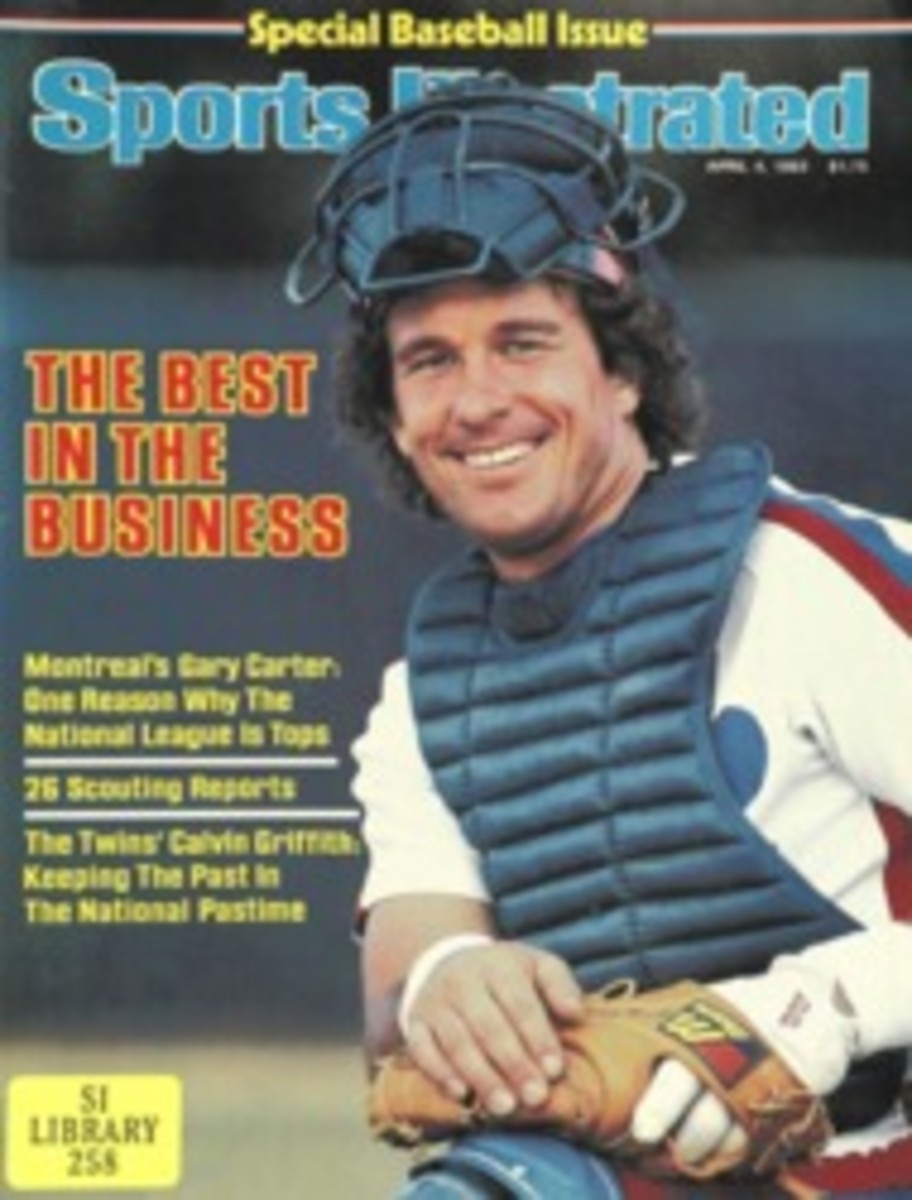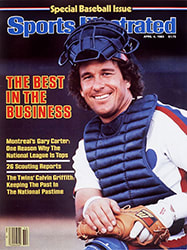
PEARL'S A GEM OF A FAN WHO'S MISSED ONE ATLANTA BALL GAME SINCE 1934
April 9, 1965 was a very special date: That day the Milwaukee—soon to be Atlanta—Braves played the Detroit Tigers in an exhibition game that was the first event ever staged at Atlanta's Fulton County Stadium. History credits one Chester Rosenberg with having been the first customer to pass through the stadium's turnstiles, but you can bet that Pearl Sandow was close behind.
She was also there a year later on opening night, when 50,671 fans came out to cheer the team which by now had become the new Atlanta Braves, only to see them lose to the Pittsburgh Pirates 3-2 in 13 innings.
She was there throughout the pennant-winning season of 1969 and the last-place seasons of 1976-79. She was there for the mediocre performances of '80 and '81 and last year's 89 wins and National League West title. As a matter of fact, she's always there. Sandow, "39 and holding interest," as she puts it, has seen 1,338 consecutive Braves home games.
Sandow's love for baseball dates back to 1934, when she started attending Atlanta Cracker minor league games in old Ponce de Leon Park. In 48 years she has missed only one Atlanta baseball game. That was in 1961, when her mother suffered a stroke. But for that, Sandow by now would easily have broken the fan's equivalent of Lou Gehrig's most notable record; he showed up for 2,130 consecutive games.
"Mother worried about that to her dying day," Sandow says. "I told her, 'Mother, if I hadn't missed that one game I never would have been in The Sporting News.' " (Pearl Sandow's absence was so newsworthy that The Sporting News did indeed note it.)
Aisle 105, row 9, seat 1 is her accustomed spot, behind the Braves' dugout, and she even receives mail there, though the Braves office forwards it to her home. "I get mail from players I knew who passed through Atlanta 30 years ago," she says.
In 1975 the Braves gave Sandow a lifetime pass, but she's uncomfortable accepting "charity," so she promptly purchased a season ticket for the seat next to her. "I bought that seat to keep my purse on," she says. "Besides, I don't want someone there talking all the time. I want to watch the game."
Sandow was a head statistician for the U.S. Housing Assistance Bureau and worked for the government for 33 years, or until she qualified for her pension. Then she quit because "work interfered with baseball."
Her home is a veritable baseball museum, a monument to her love for the game. She has 65 autographed baseballs, more than 1,000 photos, of which 300 are autographed, and ticket stubs from the 19 World Series she has attended. Her most difficult undertaking was getting Bobby Thomson to sign a ticket stub. "I was in the Polo Grounds in 1951 when he hit his famous homer off Ralph Branca," she says. "I carried that stub around with me for four years and finally got him to sign it when the Giants were playing an exhibition here in Ponce de Leon Park."
Sandow is the first fan in the park for practically every Braves game. Her hands are folded politely in her lap, and her white hair—her most distinguishing feature—is piled high atop her head, into what she calls a "snow cone." "I come early to watch batting practice," she says. "To me, it's half the fun. Sometimes it's better than the game."
Often, though, there's too much going on around her for her to see much of the b.p. People are always stopping by.
"Oh, look, there's Cecil." She waves, and the man smiles back. "Cecil played ball for the Washington Senators. He was a fine hitter. Then he went to World War II and froze his feet. He wasn't the same when he came back."
Cecil Travis was a fine hitter. In 1941 he batted .359, two points higher than Joe DiMaggio. He would have won the batting title that year if Ted Williams hadn't hit .406. When Travis retired after three dismal postwar seasons, his lifetime average was still .314, but he has never come close to making it into the Hall of Fame.
Travis and Sandow go way back to the days when his father-in-law was the groundskeeper at Ponce de Leon Park. "I been knowin' Pearl since she's been coming out to these games," Travis says. "She's an amazing woman. It don't make any difference what the weather is doing, you're going to see her sittin' right there in that seat."
Yes, Sandow is special. Al Thomy, once the sports editor of the old Atlanta Times, said, "To her, the next best thing to watching a winning baseball team is watching a losing baseball team."
She believes the role of fan is an important one. She likes the big crowds the Braves now draw, but she remembers the leaner years. "A lot of fans are just jumping on the bandwagon," Sandow says. "Half of them vanish if we lose a couple of games. I've been out here when you could almost count the people."
Her memories of the old Crackers are still fresh. "Oh, they were just marvelous," she says. "We had some Cracker teams that could have played major league baseball."
They were indeed formidable. Furman Bisher of the Atlanta Journal once wrote, "The Crackers were as powerful a name in the South as the Yankees were in the nation. They hung more pennants from their flagpole than any other team in minor league history. Only the Yankees won more."
When the Southern Association disbanded after the 1961 season, putting the Crackers into the International League, it sent Sandow 8x10 photographs of 750 players who had performed in the association. She's especially proud of these. She also has a special affection for Billy Goodman, a former American League batting champ for Boston, who early in his career had played for the Crackers. "I guess it's because he was so young when he came here." She smiles. "Only 17, I believe. I remember one day Billy came over to me and said, 'Pearl, will you go over to the [train] terminal station and get my girl, Evelyn? The manager won't let me leave.' Then he ran back onto the field without even telling me what she looked like! So I went down to the terminal station and saw this 17-year-old girl looking scared and lonely. I said, 'Are you Evelyn?' and she said, 'Yes.' I explained that Billy couldn't meet her, and I took her to the ballpark. She was a real sweet person."
Their friendship continues to this day. Sandow still receives Christmas cards from the Goodmans, and they talk regularly on the phone.
Sandow's pet on today's Braves is Jerry Royster. "I like them all, but if I have to pick one, he's my favorite," she says. "In the beginning, I liked Jerry because he wasn't getting a chance to play, and I knew he was a good player. I felt sorry for him. Last year he wasn't used much in the first part of the season, but in the last half he did a wonderful job. Whatever the Braves want him to do, he does it and never complains."
What about the manager?
"Joe Torre? Oh, he's just wonderful. I remember when he would come down from Brooklyn to visit his brother, Frank," says Sandow. "Frank used to play for the Crackers, you know. Joe would come out to the park and field grounders, shag fly balls, be a bat boy, whatever. He was a fat little boy.
"I remember the little Coke boys they had at Ponce de Leon in the 1930s. They'd see me downtown and borrow a dime for bus fare. After selling their first Cokes of the game they would come over and pay me back. One night at the park one of those little boys came over to see me. Well, actually, he wasn't a little boy anymore. He said, 'You don't know me, but I sure know you.' " Sandow, it seems, has some fans of her own.
But any discussion of the Crackers and Ponce de Leon Park would be incomplete without mention of the stately old magnolia tree that used to stand in centerfield. There was no centerfield fence, and that magnolia became a symbol of the open spaces that characterized the park. A good centerfielder there had to cover a vast territory. "Country Brown, Buddy Bates, Jack Daniels—they were the best I ever saw out there," says Sandow. "They could sure move."
Behind centerfield was a terraced bank. Up the bank was that beautiful magnolia tree. Eddie Mathews as a minor-leaguer made that tree a symbol of power—his own. "He used to bop it over that tree all the time," Sandow recalls, a distance of approximately 525 feet.
She was to have been a reluctant witness at the last game ever played at Ponce de Leon Park. It was on a Friday night in September of 1964, between the Crackers and Jacksonville. "I hope it starts raining Friday afternoon and rains all Friday night," she had said. "It will be so hard, seeing a game in this park for the last time. I'd rather have the game rained out and have it go out that way."
Pearl got her wish. The game was called because of rain. Ponce de Leon Park is no more. A parking lot covers the base paths. But the magnolia tree still stands in what used to be centerfield, and Sandow is still as avid a fan as ever as she waits for her 49th season to begin.

